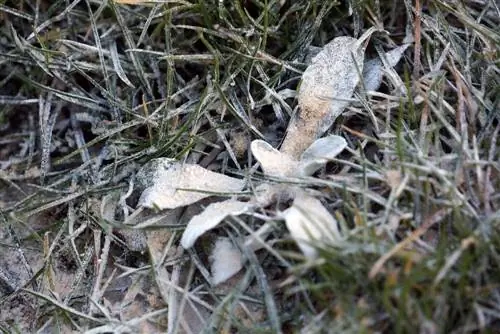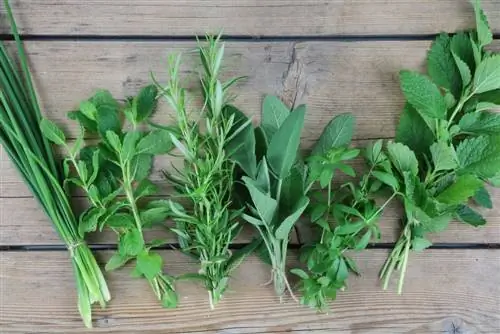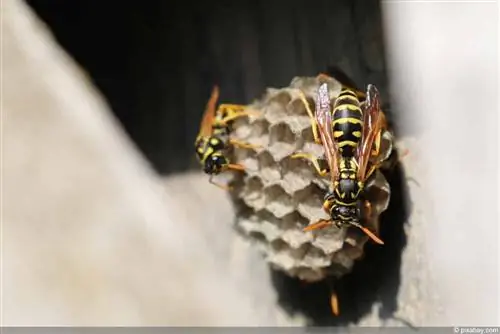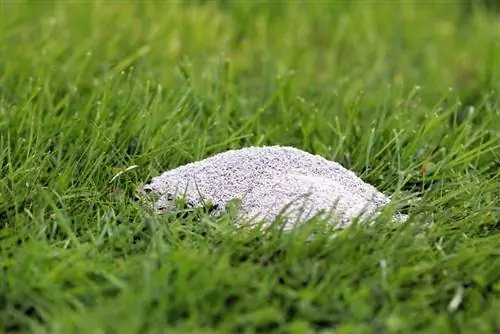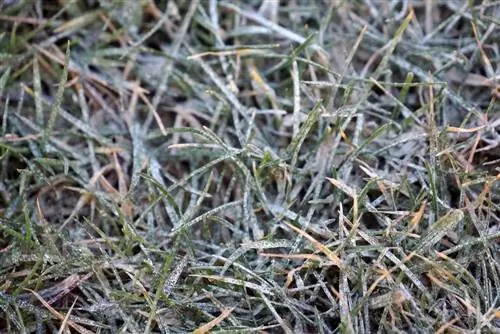- Author admin [email protected].
- Public 2023-12-17 03:39.
- Last modified 2025-01-24 12:45.
Potassium fertilizer and the effect Plants need potassium for the most part during the development of new leaves, i.e. after winter dormancy in the growth phase. The element potassium is important for resilient and he althy cell tissue in plants. It also helps the plant to be more resistant to cold and drought. Young plants generally have more potassium in them than older plants.
Crops in the garden in particular, such as potatoes, have a high potassium requirement, which can usually only be met through fertilization. If you want to achieve high yields, you should ensure that your plants have sufficient potassium supply. Potassium is essential for fruit formation. And of course also for protection against diseases, frost and heat.
Fertilizing with potassium fertilizer is necessary because the potassium silicates naturally occurring in the soil are difficult to absorb by plants. This is similar to phosphates. Potassium is needed so that plants can absorb enough water. Since water is essential for plants, potassium is one of the main nutrients in plants, as it is in other living beings. A potassium deficiency makes plants susceptible to disease. They look limp and the leaves are yellowing. However, these symptoms only appear after normal growth and normal formation and coloring of the leaves.
Afterwards, yellowing usually occurs first on the lower leaves. It doesn't matter whether the leaves are young or old. All can be affected. To remedy the potassium deficiency, foliar fertilization can also be carried out with potassium fertilizer. The underside of the leaves is treated with the fertilizer in liquid form. When using potassium fertilizer, it is best stored in humus-rich soil. In sandy and lime-rich soils there is often a lack of potassium. Here, potassium fertilizer needs to be added more often. Potassium deficiency is often accompanied by calcium deficiency. Calcium deficiency is usually not detectable as a deficiency per se.
Ingredients and production of potassium fertilizer
This type of fertilizer can be made in two ways. A first possibility arises from the mining of kainite. A second possibility, however, arises through industrial production. This creates potassium sulfate and potassium magnesia. The effect of the fertilizer is primarily caused by its composition. The single nutrient fertilizer consists of kainite and its s alts. However, it always contains 30 to 50 percent potassium. Potassium sulfate, on the other hand, is contained in so-called complex fertilizers. Potassium and sulfur can be found there. Potash magnesia is also an integral part of this fertilizer. Potassium, sulfur and magnesium come together in it.
Apply potassium fertilizer
Potassium fertilizer is very professional to use. The soil should have been analyzed beforehand. Many soils in gardens are already so fertilized that they have an abundance of potassium. However, excessive supply should be avoided if possible. As a rule, the potassium denger is used as an autumn fertilizer. If it is to be used on a lawn, it should definitely be used in high doses. Autumn is therefore recommended as a fertilizing time, as it also increases the winter hardiness of lawn grasses. Appropriate care should be given, especially if the garden consists of perennials and trees. Another advantage of fertilizing with potassium is the greater tolerance of plants in times of drought.
Potassium is very special because of its high storage capacity. Even when it rains, potassium is only washed off very easily and therefore remains present in the soil for a very long time. Adequate care can therefore be expected for one to two years. Wood ash is also recommended as an alternative because it contains a particularly high amount of potassium. Unfortunately, fertilizing with wood ash is very problematic. Since it contains a lot of lime and a high proportion of heavy metals, it is often very difficult to use.
Effect of potassium fertilizer
Potassium is a substance that plants need, especially when forming leaves. The right time for this is the period after winter dormancy for growth. Potassium means that the cell walls of plants can offer more resistance and also appear very he althy. This greatly strengthens the cell tissue. This resistance is also evident in the area of defense against cold and dry times. Very young plants usually have even more potassium than old plants.
A distinction must also be made between the plants that should be treated with potassium fertilizer. These include potatoes, for example, which require a lot of potassium. In general, this high demand can be particularly related to crops. Gardeners can only adequately cover this need through appropriate fertilization. Anyone who grows crops commercially should therefore not do without potassium fertilizer. The necessary mirror should therefore be strictly adhered to. This is specifically for fruit development. At the same time, protection against pests, diseases and frost is created.
Cause of potassium fertilization
The need to fertilize with potassium fertilizer is particularly due to the poor absorption capacity of potassium silicates. Nevertheless, it is absolutely necessary for the plants to absorb water. Potassium is therefore one of the main nutrients in plants and is therefore indispensable. Experts call it an essential nutrient. These circumstances also have consequences if there is a deficiency of the element potassium. A plant that suffers from a potassium deficiency is also much more susceptible to disease. The plants quickly let their leaves droop and even yellow. These changes are particularly noticeable when the leaves are already fully formed and the classic color of the leaves has also appeared.
The decay begins at the lower edges of the leaves. The yellowing moves from bottom to top. This can affect both young shoots and mature leaves. The infestation can affect all leaves and potassium fertilizer can also help here. In such cases, foliar fertilization becomes necessary. For this purpose, the potassium fertilizer is required in liquid form. The leaves are rubbed accordingly from the underside.
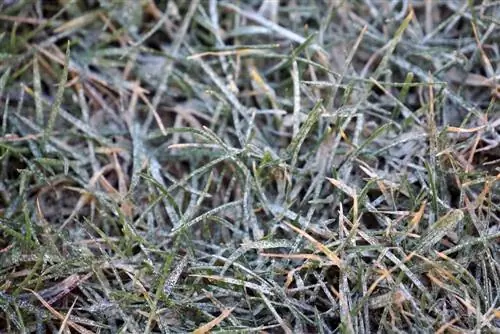
The other use of potassium fertilizer is to store it in humus-rich soil. Soils made of sand or lime can therefore suffer from a potassium deficiency. In such cases, fertilizing is best done at frequent intervals. Potassium fertilizer should therefore always be kept in stock in large quantities. In addition, a calcium deficiency often occurs at the same time. However, this cannot be determined by the gardener.
Effects of potassium fertilization
Potassium fertilizer is primarily used to regulate a plant, more precisely to regulate the potassium balance. The focus is on the well-being of the plant and the resistance of the plant is increased. This means pests and diseases have no chance. Particular attention should be paid to fruit trees and vegetable beds. They have a very high demand because they are supposed to produce fruit in the spring after the winter period. Houseplants must be excluded from fertilization with potassium fertilizer. However, the application should only be used on plants in the garden. This is the only way a he althy plant can survive in the garden.
What you should know about potassium fertilizer in brief
Potassium as an element is usually sufficiently present in the soil, but in the form of potassium silicates. This means that the plants have difficulty absorbing it, similar to phosphate. Plants need potassium for their general well-being and resilience. It allows the plant's cells to absorb more water. A potassium deficiency makes plants susceptible to disease. They look limp and the leaves are yellowing. However, these symptoms only appear after normal growth and normal formation and coloring of the leaves.
- Plants usually already store potassium, but these resources become depleted as they age.
- Young plants have more potassium than older plants.
- If you use fertilizer, you should, above all, make sure that it contains the highest proportion of potassium.
- If all other nutrients are present in sufficient quantities, a pure potassium fertilizer is recommended.
Particularly after hibernation, plants need potassium and phosphate, but nitrogen is hardly used. This is therefore the right time to use a potassium fertilizer.
- Lawn needs potassium. This is why autumn lawn fertilizers are often referred to as potassium fertilizers.
- Crops in particular need a lot of potassium. The need can usually only be met through fertilization.
- In agriculture, fertilizing with special potassium fertilizer is common practice, especially for potatoes and rapeseed.
- Even in forestry, potassium fertilizer is often used because potassium is needed to build wood.
- From this we can also conclude that potassium is also needed by fruit trees and bushes in the home garden.
- Houseplants with woody parts also urgently need potassium for their he alth.
- Potassium fertilizer is often indispensable, especially for bonsai lovers, so that they can enjoy their plants for years to come.
Despite everything, every plant needs potassium and you should make sure you get enough of it. The condition of the soil is important for the supply of potassium. Humic soils are well able to absorb potassium, while acidic soils often suffer from a potassium deficiency, so fertilization is usually essential.

